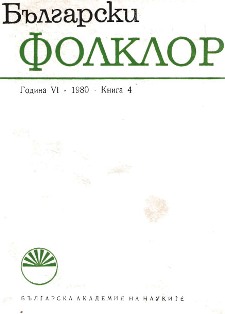„Песните за големия преход” във фолклора на балканските народи (Общи проблеми на песните, свързани със смъртта и погребението)
The “Songs of the Great Passage” in the Balkan Peoples’ Folklore (Common Problems of the Songs Connected with Death and Obsequies).
Author(s): Fani Angelieva, Yordanka HolevichSubject(s): Anthropology
Published by: Институт за етнология и фолклористика с Етнографски музей при БАН
Summary/Abstract: A part of the „songs of the Great Passage” (after A. Van Gennep’s definition) from the folklore of the Balkan peoples has been taken as an object of study. Some of the specific features in the existence and the artistic peculiarities of these songs are manifested in certain parts of the vast region known as „the Balkans”, while elsewhere within the same region other features of theirs could be found. Their identity and dissimilarities, which are the result of the historical motion of essentially heterogeneous processes, have been traced with a view to their theoretical and historical elucidation rather than to the comparative study of folklore. The songs have been examined in their relation to ancient mythical beliefs and to rite. Their poetic peculiarities, musical formation, manner of performance, denominations have been generally outlined. The following conclusions could be drawn from these observations: The songs reveal a comparatively developed stage of mythological thinking. Traces of ancient myths are evident in them. The transformation from a mythological conception of the world to a metaphorical one is revealed in the entire systematic character of the ritual complex. The creation of stable rituals – the unity of rite and song – does not replace the comparatively independent existence of the songs separated from the system of customs and rites. One and the same song or motif may take various functions. Not only does a link exist among all the Balkan peoples between funerary songs and rites (obsequies) and wedding ones, but also laments may function as songs at working-bees, at harvest, at the table, as lullabies and love songs, etc. The relations and mutual interpenetrations between personal art – literary and musical – and folk art are of a particular importance. The oral characteristic presents one of the factors which helped the appearance during the Middle Ages and in more recent times of a culture of an intermediary type. The historical dynamics of laments also throws light upon the question about the appearance of the lyric – song or verse, personal or pertaining to the intermediary culture. We could presume that it came to a real life when it broke apart from the system of rites and customs and acquired an inner structure of its own. Certain samples among the laments of some Balkan peoples do support this assumption. Funerary rites and songs allow us to accept the existence of the Balkan unity.
Journal: Български фолклор
- Issue Year: VI/1980
- Issue No: 4
- Page Range: 10-24
- Page Count: 15
- Language: Bulgarian
- Content File-PDF

